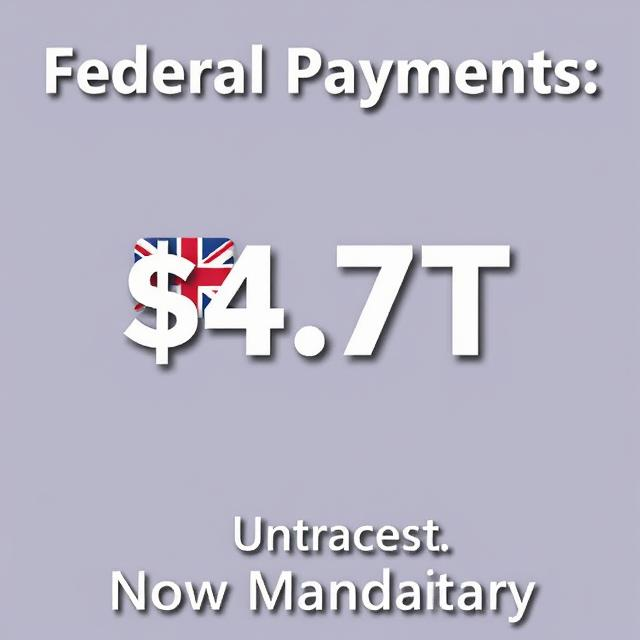$4.7 Trillion in Federal Payments Left Untraced—New Tracking System Now Mandatory
Government Implements Stricter Financial Oversight Measures
In a major move toward increasing transparency and accountability in government spending, the Department of Government Efficiency has announced that the Treasury Access Symbol (TAS) is now mandatory for all federal transactions. Previously, this tracking system was optional, leaving an estimated $4.7 trillion in payments untraced. The lack of oversight over such a massive sum of taxpayer money has raised concerns about financial mismanagement, fraud, and waste.
With this policy update, the government aims to ensure that every transaction is properly recorded and tracked, minimizing the risk of misallocation and unauthorized expenditures. While this decision has been met with both support and criticism, it marks a significant shift in how federal funds are monitored.
Understanding the TAS System: A Tool for Financial Accountability
The Treasury Access Symbol (TAS) is an identification system that categorizes federal transactions. It allows government agencies to track payments, audit expenditures, and ensure that funds are being used for their intended purposes.
For years, financial analysts and government watchdog groups have called for a more stringent application of the TAS system. They argue that without a mandatory tracking mechanism, it becomes difficult to determine how taxpayer dollars are allocated and whether they are being used efficiently.
Despite these concerns, the government had allowed billions of dollars to move through federal agencies without a required tracking symbol, making it nearly impossible to trace certain transactions. This lack of oversight created potential risks of financial mismanagement and fraud, ultimately prompting the latest policy shift.
$4.7 Trillion in Untraced Federal Payments: A Growing Concern
The revelation that $4.7 trillion in federal payments went largely unaccounted for has sparked intense debate. Critics argue that allowing such an enormous sum to go untraced raises serious questions about government accountability.
Several key concerns have emerged:
- Risk of Fraud and Waste
- Without proper tracking, federal funds are more vulnerable to misuse, inefficiency, or corruption.
- A lack of detailed financial records makes audits and oversight more difficult.
- Lack of Transparency
- The American public has the right to know how their tax dollars are being spent.
- A more transparent system ensures that funds are allocated properly and used for their intended purposes.
- Delayed Oversight and Policy Implementation
- Critics question why the government allowed such a massive loophole to exist for so long.
- Some are demanding a full audit of past untraced transactions to ensure that funds were not misused.
While no direct evidence of fraud or corruption has been linked to the untraced funds, many argue that the lack of oversight itself is cause for concern. The introduction of a mandatory TAS requirement is seen as a long-overdue correction to prevent future financial discrepancies.
Public and Political Reactions to the Policy Change
The decision to enforce stricter tracking measures has generated mixed reactions from financial experts, policymakers, and the general public.
- Supporters argue that the new policy is a necessary step toward accountability and fiscal responsibility. They believe that tracking every dollar spent ensures more efficient government operations.
- Critics question why it took so long to implement this measure and argue that past financial mismanagement should be investigated.
- Transparency advocates are pushing for even stronger reforms, such as publicly accessible records of federal spending and independent audits.
A government spokesperson defended the change, stating:
“This update is a crucial step toward ensuring greater transparency in federal spending. The TAS requirement will help us track funds more effectively and prevent future financial oversight issues. Our goal is to ensure that every taxpayer dollar is accounted for and used responsibly.”
However, some lawmakers remain skeptical, arguing that simply making the TAS mandatory is not enough. They are calling for:
- Independent financial audits of previous untracked transactions.
- Clearer reporting requirements for all government agencies.
- Stronger penalties for financial mismanagement or failure to properly track funds.
What Happens Next? Implementation and Enforcement
With the new TAS requirement now in effect, all federal agencies and departments must:
- Ensure that every transaction includes a valid TAS to track payments.
- Update internal accounting and reporting systems to comply with the new mandate.
- Cooperate with the Department of Government Efficiency for oversight and auditing.
- Provide regular reports on how funds are allocated and used.
While this policy shift is expected to increase transparency, experts warn that implementation challenges remain. Agencies may face technical and logistical hurdles in fully adopting the new system, and effective enforcement will be critical to preventing financial mismanagement.
Final Thoughts: A Step Toward Greater Accountability
The decision to make TAS tracking mandatory marks a significant change in how federal funds are monitored. However, the fact that $4.7 trillion in payments previously went untraced highlights deep-rooted issues in financial oversight that cannot be solved overnight.
While the new tracking system is a step in the right direction, additional reforms—including independent audits, stronger accountability measures, and improved public transparency—may be necessary to fully restore public trust in government financial management.
As the new regulations take effect, the focus will be on whether these measures lead to tangible improvements in tracking federal expenditures. The coming months will likely reveal whether additional reforms are needed or if the mandatory TAS requirement alone is enough to ensure proper financial oversight moving forward.
This remains a developing story, and further updates are expected as government agencies work to implement the new tracking system and address public concerns.

